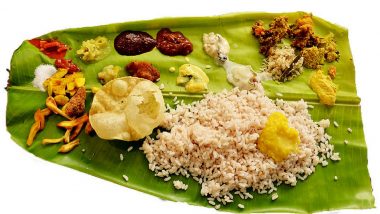The best part about having Malayali friends is the possibility that they may someday invite you for a scrumptious Kerala-style sadhya. And with Vishu around the corner, the time is just ripe for getting chummy with your Malayali colleague whom you didn’t speak to for the good part of the year. For those of you who don’t know what a sadhya is, think of it as a South Indian thaali, minus all the metal cutlery and plates. It’s a feast comprising delicious vegetarian delicacies – curries, subjzis, etc. -- made from season vegetables and served on a banana leaf. Although the sadhya can be served on any joyous occasion (birthdays, promotions, wedding, etc.), the festive sadhyas are almost always compulsory. Here's everything you need to know about Vishu, the Malayalam new year.
Common Sadhya Dishes
The sadhya comprises a medley of traditional vegetarian dishes, made from the choicest seasonal produce. The dishes are served on a banana leaf one-by-one, followed by rice, which is topped off with dal, ghee and sambar. Traditional desserts are payasam made two ways: one with milk and rice and the other with rice, jaggery and coconut milk. Here’s a list of some common fixtures during the sadhya:
Upperi: Golden-fried banana chips are served right at the beginning alongside salt. For the interest of the impatient ones, the chips keep you engaged till the time all the dishes are served.
Sharkara varatti: Almost a mouthful to pronounce, sharaka varatti is a sweet banana chip rolled in jaggery and dried herbs. It is served along with the upperi.
Pulinji: The name of the dish is a portmanteau of its two major ingredients puli (tamarind) and inji (ginger), the sweet-and-sour pickle is among the first things to be served on the leaf. It is an appetiser meant to whet your hunger and to clean your palate.
Acchar: Served alongside the pulinji, the achar also helps to clean the palate. Although the traditional favourite is mango, lime pickles are also served during the sadhya.
Pachadi: Pachadi is a yoghurt-based dish prepared from vegetables such as bottle gourd, yellow cucumbers and pumpkin. The dish is flavoured with a mustard seed-cumin-curry leaf- red chilli tempering.
Kichadi: Like pachadi, kichadi is also yoghurt based. It’s traditionally prepared with cucumber, white gourd, etc. A sweet-and-sour version of the dish featuring pineapple is also quite popular.
Kootukari: Kootukari could either mean ‘the paired curry’ or ‘the mixed curry.’ Second in command to the sambar, kootikari is made of Bengal gram, coconut and a medley of vegetables like yam. The dish is also a medley of textures and flavours.
Kaalan: Kaalan is a bright-yellow yoghurt-based gravy with yams or raw bananas, served with a tempering of mustard, red chillies and curry leaves.
Eriserry: This hot and sweet curry is coconut-based with pumpkin, yam and black-eyed peas.
Olan: This is a mildly-flavoured curry with a coconut-milk base. It comprises gourd vegetables and beans. Made with minimal ingredients, the olan is an all-time favourite.
Avial: Probably the second-best recognised sadhya dish after the sambar, the dish contains every seasonal vegetable imaginable, from carrots to raw bananas in a curd-coconut-based gravy. Here’s some trivial: The dish also inspired the name for a popular South Indian rock band. Also, the dish is supposed to have been invented by the Pandava brother Bhima during their exile.
Thoran: Any dry subzi, usually made with veggies like cabbage, leafy greens and carrot with a tempering of coconut, mustard and curry leaves, is called a thoran. Depending upon the season, the choice of vegetables for the thoran can change.
Rice: The king and the star carb of the sadhya leaf is the rice. In Kerala, the rose-hued Palakkadan matta rice is served for Vishu. Not only does it keep you full for longer, it is loaded with micronutrients.
Parippu: Parippu is simply cooked dal, flavoured only with a hint of turmeric and salt. It is served just before sambar with a generous helping of ghee.
Sambar: Although the dish needs no introduction, sambar is a vegetable curry with a base of dal and coconut, flavoured with asafoetida and tamarind. Along the savouries, it is the last to arrive and is followed by rasam, chaas and payasam.
Rasam: A thin soup-like dish, flavoured heavily with asafoetida and tamarind, rasam is had like a digestive.
Payasam: The pièce de résistance of every sadhya meal has to be the twin payasams, especially the pal payasam made with milk, sugar and rice. Although not as popular as the pal payasam, the jaggery-based payasam also enjoys a faithful fan following. A dal-based payasam known as the pradhaman is also served at some sadhyas.
In some parts of the state, Vishu Katta (translated as Vishu dumpling) and Vishu kanji (Vishu gruel) is served as delicacies. Although in most districts sadhya is mostly a vegetarian affair, it’s not uncommon to see chicken, fish, mutton or egg delicacies served with ghee rice in the northern districts of Kerala.
The Science of Serving the Sadhya
If you thought these dishes were served haphazardly, you are mistaken; there’s a definite method to the madness. Firstly, the leaf in which the sadhya is served should always be pointed towards your left. Each dish, starting with the salt should be served in a clock-wise manner starting from the left. Pickles and salt are served at the bottom left. The upperi, sharkara, thoran, pachadi, kichadi, olan, eriserry, avail, kalan and kootukari are then served in a clock-wise manner ending to the right. The rice is then topped with parippu and a generous drizzling of ghee. Till the sambar is served, you can keep yourself busy and sample some of the dishes served.
The right way of having the payasam is not sipping out of a cup but by pouring it out on the leaf once you polish off all the food. It has to be slurped off the leaf with your fingers. The sweetness of the payasam contrasts beautifully with the remnants of the savoury food on the leaf. It’s customary to accompany the payasam with a pappad and a banana.
Places in Mumbai That Serve Sadhya for Onam and Vishu
If your snooty Mallu acquaintance didn’t invite you for the sadhya, don’t sulk. You can always head to these amazing places in Mumbai to have your fill. But expect a bumper crowd to turn up so pre-book your seats.
Taste of Kerala, Fort
For an authentic sadhya experience, head out to Fort in South Mumbai and ask for Taste of Kerala. It’s a two-storied restaurant, which serves authentic Malayali food complete with the rosy matta rice. You can also sample some of their nonvegetarian fare and can fearlessly ask for a piece of fish fry without getting a scowl in return. The prices are on the affordable side.
Hotel Deluxe, Fort
Situated in the same backyard as Taste of Kerala, Hotel Deluxe is another authentic Malayali restaurant, serving great sadhya. You can also try out other Keralite delicacies like appams, pazhampori etc. if you are in a mood for more than just sadhya.
Grace, Nerul, Navi Mumbai
The pride and joy of every Malayali in Navi Mumbai, Grace is as authentic as it gets in this part of the city. Known more for its nonvegetarian fare, Grace also whips up a great sadhya.
Theeram, Kalina, Santacruz
Theeram is where Malayalis from the western side of Mumbai head to for a scrumptious lunch. Their unlimited thaali is something that you need to keep an eye out for.
Sneha, Mahim
Did you know that the restaurant has international repute for its famous Kerala-style beef fry? The dish was conferred the ‘Tastiest Beef in Asia’ honour by Chowster, global network of food enthusiasts, putting the tiny restaurant on the international map. But that’s not the only thing it’s famous for. You can also head out to Sneha during Vishu for an authentic sadhya.
Kerala Hut, CBD, Belapur, Navi Mumbai
A small hole-in-the-wall restaurant from CBD Belapur serves a lip-smacking sadhya. The space constraints may cause your leaves to overlap. Rest assured, the food is amazing!
KKP, Manpada, Thane
Thaneites can indulge themselves this Vishu by visiting KKP Restaurant in Thane, Manpada for a delicious sadhya. The restaurant promises a heady 33-dish course, comprising eight appetisers; four curries; five subzjis like avial, erissery and toran; and (the best part) nine sweets and beverages.
Vishu will be celebrated this year on April 14. So head out to any of these places to sample some of the best authentic Malayali dishes. A few pieces of advice from someone who has had one too many sadhyas: Wear loose pants with an expandable waist (thank us later), do not get intimidated by all the food and whatever you do, do not hurry through the meal. Keep an old Malayali adage in mind: "Paiyye thinnal panayum thinnam." It means, "If you eat slowly, you could eat a whole palm tree."
(The above story first appeared on LatestLY on Apr 12, 2018 12:24 PM IST. For more news and updates on politics, world, sports, entertainment and lifestyle, log on to our website latestly.com).













 Quickly
Quickly













